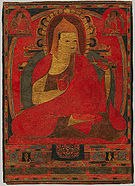- Deva dynasty
-
Deva dynasty ← 
CE 1200s–CE 1300s  →
→Capital Bikrampur Language(s) Sanskrit
BengaliReligion Hinduism Government Monarchy Historical era Medieval India - Established CE 1200s - Disestablished CE 1300s Part of a series on the History of Bengal 
Ancient Bengal Vedic Period Ancient Bengali States
Gangaridai Kingdom, Vanga Kingdom,
Pundra Kingdom, Suhma Kingdom,
Anga Kingdom, Harikela KingdomMauryan Period Classical Bengal The Classical Age Shashanka Age of Empires
Pala Empire, Sena EmpireMedieval Bengal Arrival of Islam
Sultanate of Bengal, Deva Kingdom
Bakhtiyar Khilji, Raja GaneshaMughal Period
Pratap Aditya, Raja Sitaram Ray
Nawab of Bengal, Baro-BhuyansModern Bengal Company Raj
Zamindari system, Bengal famine of 1770British Indian Empire
Bengal Renaissance
Brahmo Samaj
Swami Vivekananda, Jagadish Chandra Bose,
Rabindranath Tagore, Subhash Chandra BosePost-Colonial
1947 Partition of Bengal, Bangladesh Liberation War
Sheikh Mujibur Rahman, Jyoti BasuSee Also Bangladesh, West Bengal Deva Dynasty (c.12th-13th century) was a Hindu dynasty of early medieval Bengal, ruled over eastern Bengal after the Sena dynasty. The capital of this dynasty was Bikrampur in present-day Munshiganj District of Bangladesh. The end of this dynasty is not yet known.
This Hindu Vaishnava dynasty is different from an earlier Buddhist Deva dynasty (c. 8th-9th century) of Samatata, whose capital was Devaparvata. This earlier dynasty is now known in greater details from the Mainamati excavations. Though a number of their inscriptions, coins and sealings were known earlier, the extent of their rule was actually revealed through the extraordinarily rich archaeological remains recovered from the undisturbed early levels of Mainamati. Four rulers of this dynasty are known from the inscriptions: Shantideva, Viradeva, Anandadeva and Bhavadeva.[1]
Rulers
The major sources of the history of this dynasty are the three copperplate inscriptions of Damodaradeva issued in the Saka era 1156, 1158 and 1165, which were his 4th, 6th and 13th regnal years. The first three rulers are known from the Chittagong copperplate inscription of Damodaradeva dated Saka era 1165. The first ruler of this dynasty was Purushottamadeva, who rose from the position of a village-chief (gramani). His son Madhumathana or Madhusudanadeva was the first independent ruler of this dynasty, who assumed the title of Nripati. He was succeeded by his son Vasudeva and Vasudeva was succeeded by his son Damodaradeva. Damodaradeva (reigned 1231–1243) was the most powerful ruler of this dynasty. He took the title of Ariraja-Chanura-Madhava-Sakala-Bhupati-Chakravarti. The inscriptional evidences show that his kingdom was extended up to the present-day Comilla-Noakhali-Chittagong region. A later ruler of this dynasty Ariraja-Danuja-Madhava Dasharathadeva extended his kingdom up to Bikrampur and made it his capital.[2] He issued an inscription from here. Yahya bin Ahmad in his Tarikh-i-Mubarak Shahi mentioned that he (referred as Danuj Rai of Sonargaon by Yahya) made an alliance with Ghiyas-ud-Din Balban in 1281.[3]
Preceded by
Sena dynastyBengal dynasty Succeeded by
Mamluk dynastySee also
References
- ^ Banglapedia article on Deva dynasty
- ^ Roy, Niharranjan (1993). Bangalir Itihas: Adiparba Calcutta: Dey's Publishing, ISBN 81-7079-270-3, pp.408-9
- ^ Majumdar, R.C. (ed.) (2006). The Delhi Sultanate, Mumbai: Bharatiya Vidya Bhavan, p.622
Categories:- Former monarchies of Asia
- Former countries in Asia
- Dynasties of Bengal
- Historical Hindu empires
- History of Bangladesh
- History of Bengal
- History of medieval India
- Dynasties of India
- Hindu dynasties
- States and territories established in the 11th century
Wikimedia Foundation. 2010.
